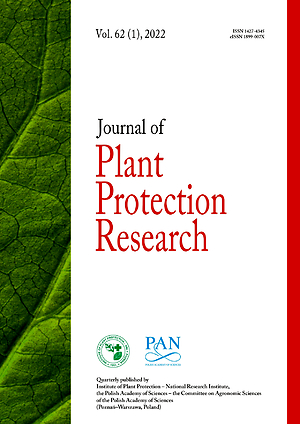RAPID COMMUNICATION
Isolation and characterization of Alternaria malorum as a causal agent of bark canker on walnut trees
1
Department of Plant Protection, Faculty of Agriculture, Bu-Ali Sina University, Hamedan, Iran
A - Research concept and design; B - Collection and/or assembly of data; C - Data analysis and interpretation; D - Writing the article; E - Critical revision of the article; F - Final approval of article
Submission date: 2021-08-31
Acceptance date: 2021-10-14
Online publication date: 2022-03-04
Corresponding author
Doustmorad Zafari
Department of Plant Protection, Faculty of Agriculture, Bu-Ali Sina University, Hamedan, Iran
Department of Plant Protection, Faculty of Agriculture, Bu-Ali Sina University, Hamedan, Iran
Journal of Plant Protection Research 2022;62(1):102-106
HIGHLIGHTS
- Alternaria malorum as the causal agent of bark canker on walnut trees
- Alternaria malorum is a new fungal pathogen of walnut trees in the world
- Identification the pathogenic fungus caused bark canker disease on walnut trees on the basis of morphological characteristics and molecular assay for the first time in the world
- The present study was focused on identification of causal agent, which involve in pathogenicity. It comprises systematics, taxonomy and pathogenicity
KEYWORDS
TOPICS
ABSTRACT
During 2016–2020, a longitudinal bark canker was observed on walnut branches in some
of the provinces of Iran. The symptoms appeared on one side of the branches. No visible
symptoms were observed on the sapwood after removal of the bark using a blade. In order
to detect a potential agent of these symptoms on walnut trees, collected samples were transferred
to the laboratory for further investigation. After isolation and purification based on
standard methods, a fungus was frequently isolated from symptomatic tissues. Morphological
and molecular assays indicated that the responsible agent of this disease was Alternaria
malorum, moreover, a pathogenicity test confirmed that A. malorum was pathogenic
on walnut trees. To the best of our knowledge, this study represents the first attempt to
identify A. malorum as a new causative agent of bark canker on walnut trees in the world.
ACKNOWLEDGEMENTS
The authors would like to thank the Research Deputy
of the University of Bu-Ali sina, Hamedan, Iran for
their financial support of this project.
RESPONSIBLE EDITOR
Lidia Irzykowska
CONFLICT OF INTEREST
The authors have declared that no conflict of interests exist.
REFERENCES (18)
1.
Alidadi A., Javan-Nikkhah M., Kowsari M., Karami S., Ebrahimi Rastaghi M. 2018. Some species of fungi associated with declined Persian oak trees in Ilam province with emphasis on new records to mycobiota of Iran. Rostaniha 19 (2): 75–91.
2.
Asgari B., Zare R., Payghami E. 2004. Hyphomycetous fungal community of barley phylloplane in East Azarbaijan province with emphasis on new taxa for Iranian fungal flora. Rostaniha 5 (2): 171–197.
3.
Bagherabadi S., Zafari D., Amirabad Y.M., Woudenberg J.H. 2017. First report of leaf spot caused by Alternaria alternata on Drimia maritima. Journal of General Plant Pathology 83 (6): 398–401. DOI: https://doi.org/10.1007/s10327....
4.
Barnett H.L., Hunter B.B. 1972. Illustrated Genera of Imperfect Fungi. Burgess Publishing Company, Minneapolis, Minnesota, USA.
5.
Braun U., Crous P.W., Dugan F., Groenewald J.E., De Hoog G.S. 2003. Phylogeny and taxonomy of Cladosporium-like hyphomycetes, including Davidiella gen. nov., the teleomorph of Cladosporium s. str. Mycological Progress 2 (1): 3–18.
6.
Crous P.W., Braun U., Wingfield M.J., Wood A.R., Shin H.D., Summerell B.A., Alfenas A.C., Cumagon C.J.R., Groenewald J.Z. 2009. Phylogeny and taxonomy of obscure genera of microfungi. Persoonia 22: 139–161.
7.
Davari M., Arzanlou M., Babai-Ahari A. 2011. Identification of some fungal species involved in biodegradation of petroleum pollutants in Northwest of Iran. Rostaniha 12 (1): 1–12.
8.
Dugan F.M., Roberts R.G., Hanlin R.T. 1995. New and rare fungi from cherry fruits. Mycologia 87 (5): 713–718.
9.
Goetz J., Dugan F.M. 2006. Alternaria malorum: a mini-review with new records for hosts and pathogenicity. North American Fungi 1 (1): 1–8. DOI: 10.2509/pnwf.2006.001.003.
10.
Hall T.A. 1999. BioEdit: a user-friendly biological sequence alignment editor and analysis program for Windows 95/98/NT. Nucleic Acids Symposium Series 41: 95–98.
11.
Hergholi N., Ghosta Y., Javan-Nikkhah M., Campisano A., Pancher M. 2015. New species of endophytic fungi from grapevine (Vitis vinifera) in Iran. Rostaniha 16 (1): 17–35.
12.
Hoff J.A., Klopfenstein N.B., McDonald G.I., Tonn J.R., Kim M.S., Zambino P.J., Hessburg P.F., Rogers J.D., Peever T.L., Carris L.M. 2004. Fungal endophytes in woody plants of Douglas-fir (Pseudotsuga menziesii) and ponderosa pine (Pinus ponderosa). Forest Pathology 34 (4): 255–271.
13.
Kimura M. 1980. A simple method for estimating evolutionary rates of base substitutions through comparative studies of nucleotide sequences. Journal of Molecular Evolution 16 (2): 111–120. DOI: 10.1007/BF01731581.
14.
Kumar S., Stecher G., Tamura K. 2016. MEGA7: molecular evolutionary genetics analysis version 7.0 for bigger datasets. Molecular Biology and Evolution 33: 1870–1874. DOI: https://doi.org/10.1093/molbev....
15.
Ruehle G.D. 1931. New apple-rot fungi from Washington. Phytopathology 21 (12): 1141–1152.
16.
Sharma A.D., Gill P.K., Singh P. 2002. DNA isolation from dry and fresh samples of polysaccharide-rich plants. Plant Molecular Biology Reporter 20 (4): 415. DOI: https://doi.org/10.1007/BF0277....
17.
Sohrabi M., Mohammadi H. 2020. First report of Graphium carbonarium associated with walnut dieback in Iran. Mycologia Iranica 7 (1): 149–153. DOI: 10.22043/mi.2020.122504.
18.
Woudenberg J.H.C, Groenewald J.Z., Binder M., Crous P.W. 2013. Alternaria redefined. Studies in Mycology 75: 171–212. DOI: https://doi.org/10.3114/sim001....
We process personal data collected when visiting the website. The function of obtaining information about users and their behavior is carried out by voluntarily entered information in forms and saving cookies in end devices. Data, including cookies, are used to provide services, improve the user experience and to analyze the traffic in accordance with the Privacy policy. Data are also collected and processed by Google Analytics tool (more).
You can change cookies settings in your browser. Restricted use of cookies in the browser configuration may affect some functionalities of the website.
You can change cookies settings in your browser. Restricted use of cookies in the browser configuration may affect some functionalities of the website.




